 Open Access
Open Access
ARTICLE
SRC: Superior Robustness of COVID-19 Detection from Noisy Cough Data Using GFCC
1 Department of Computer Science & Engineering, Government College of Engineering, Kalahandi, Bhawanipatna, 766002, India
2 Department of Computer Science and Information, Taibah University, Medina, 42353, Saudi Arabia
3 School of Information Technology and Engineering, VIT University Vellore, 632014, Tamil Nadu, India
4 Computer Science Department, College of Computer Science and Engineering, Taibah University, Medina, 42353, Saudi Arabia
* Corresponding Author: Mohammad Zubair Khan. Email:
Computer Systems Science and Engineering 2023, 46(2), 2337-2349. https://doi.org/10.32604/csse.2023.036192
Received 20 September 2022; Accepted 08 December 2022; Issue published 09 February 2023
Abstract
This research is focused on a highly effective and untapped feature called gammatone frequency cepstral coefficients (GFCC) for the detection of COVID-19 by using the nature-inspired meta-heuristic algorithm of deer hunting optimization and artificial neural network (DHO-ANN). The noisy crowdsourced cough datasets were collected from the public domain. This research work claimed that the GFCC yielded better results in terms of COVID-19 detection as compared to the widely used Mel-frequency cepstral coefficient in noisy crowdsourced speech corpora. The proposed algorithm's performance for detecting COVID-19 disease is rigorously validated using statistical measures, F1 score, confusion matrix, specificity, and sensitivity parameters. Besides, it is found that the proposed algorithm using GFCC performs well in terms of detecting the COVID-19 disease from the noisy crowdsourced cough dataset, COUGHVID. Moreover, the proposed algorithm and undertaken feature parameters have improved the detection of COVID-19 by 5% compared to the existing methods.Keywords
COVID-19 disease had spread like wildfire around the world after December 2019. This life-threatening COVID-19 disease was declared a global pandemic, and many researchers have carried out the detection of coronavirus from the infected people by using Artificial Intelligence (AI) based Machine Learning (ML) techniques [1–6]. In the current market, the reverse transcription polymerase chain reaction (RT-PCR) is a gold standard testing strategy for detecting the COVID-19 virus. However, RT-PCR processing is time-consuming and more expensive [7]. COVID-19 infected people have an array of symptoms such as fever, cough, shortness of breath, fatigue, body aches, headache, loss of test, loss of smell, sore throat, runny nose, congestion, vomiting, diarrhea etc. It has been reported by the World Health Organization (WHO) that 67.7% of COVID-19 patients have dry cough symptoms [8]. Recent researchers worldwide carry out dry cough symptom analysis to identify COVID-19 at the early stage of the coronavirus before the deadly virus becomes fatal [9]. The COVID-19 infection identification from cough data set using AI and ML paves the way to discover an affordable, simple, quick, and accurate mechanism.
Grant et al. [10] applied Mel-frequency cepstral coefficients (MFCCs), and Relative spectral-perceptual linear prediction (RASTA-PLP) features from the crowdsourced database with two different classification techniques, random forests (RF) and deep neural networks (DNN) to detect COVID-19 [8]. Using machine learning, Stasak et al. [11] used glottal, prosodic, spectral from short-duration speech segments for automatic COVID-19 classification. Dash et al. [12] improved the efficiency of COVID-19 detection by using the COVID-19 Coefficient (C-19CC). Sharma et al. [13] applied temporal and spectral acoustic features such as MFCCs (13-D), spectral roll-off, spectral centroid, mean square energy zero crossing rate, spectral bandwidth, etc., from respiratory sounds using random forest classifiers for point-of-care diagnosis of respiratory infection. Schuller et al. [14] used COMPARE acoustic feature set for the binary classification of COVID-19 infection.
Miranda et al. [15] used Short Time Fourier Transform (STFT), MFCC, Mel-filter Bank (MFB) using Deep Neural Network (DNN), convolutional Neural Network (CNN), and Long-Short Term Memory (LSTM) for acoustic cough detection. Monge-Alvarez et al. [16] applied local Hu moments Robust detection of audio-cough events with 88.51% sensitivity and 99.7% specificity in various noise conditions. Quatieri et al. [17] established a framework for vocal biomarkers of COVID-19 based on respiration, phonation, and articulation. Schuller et al. [18] provided an overview of the contribution towards the sars-cov-2 corona crisis using speech and sound analysis.
This proposed work emphasized on detection of COVID-19 in a noisy crowdsource cough dataset. Noise is an integral and unavoidable unit during the collection of crowdsource speech data for future usage in COVID-19 analysis through AI and ML techniques. However, the performance of the AI-based machine learning techniques reduces greatly in the presence of a noisy data set. The focus was on noise robustness speech features called Gammatone Cepstral Coefficients (GFCCs), which are untapped feature parameters for detecting COVID-19 infection. The untouched meta-heuristic-based machine learning algorithms were applied to detect COVID-19 infection using GFCCs feature vectors in the noisy public domain crowdsource cough dataset.
The research objectives are:
• To analyze the GFCC features to detect COVID-19 infection in a noisy cough dataset and compare the results with most features applied in COVID-19 detection.
• To apply different untouched metaheuristic algorithms for the detection of COVID-19 from noisy crowdsourced cough data and compare their performances.
• To propose a hybrid algorithm combining nature-inspired metaheuristic algorithms based on DHO and neural networks.
• To perform a rigorous validation of the proposed method and undertaken feature vectors.
The remaining manuscript is designed: Section 2 discusses the crowdsourced cough data set and feature parameters selection. Section 3 emphasizes nature-inspired meta-heuristic-based ANN. Section 4 analyses the findings of this research work, and Section 5 focuses on the conclusion and future work.
2 Crowdsourced Cough Data Set and Feature Parameter Selection
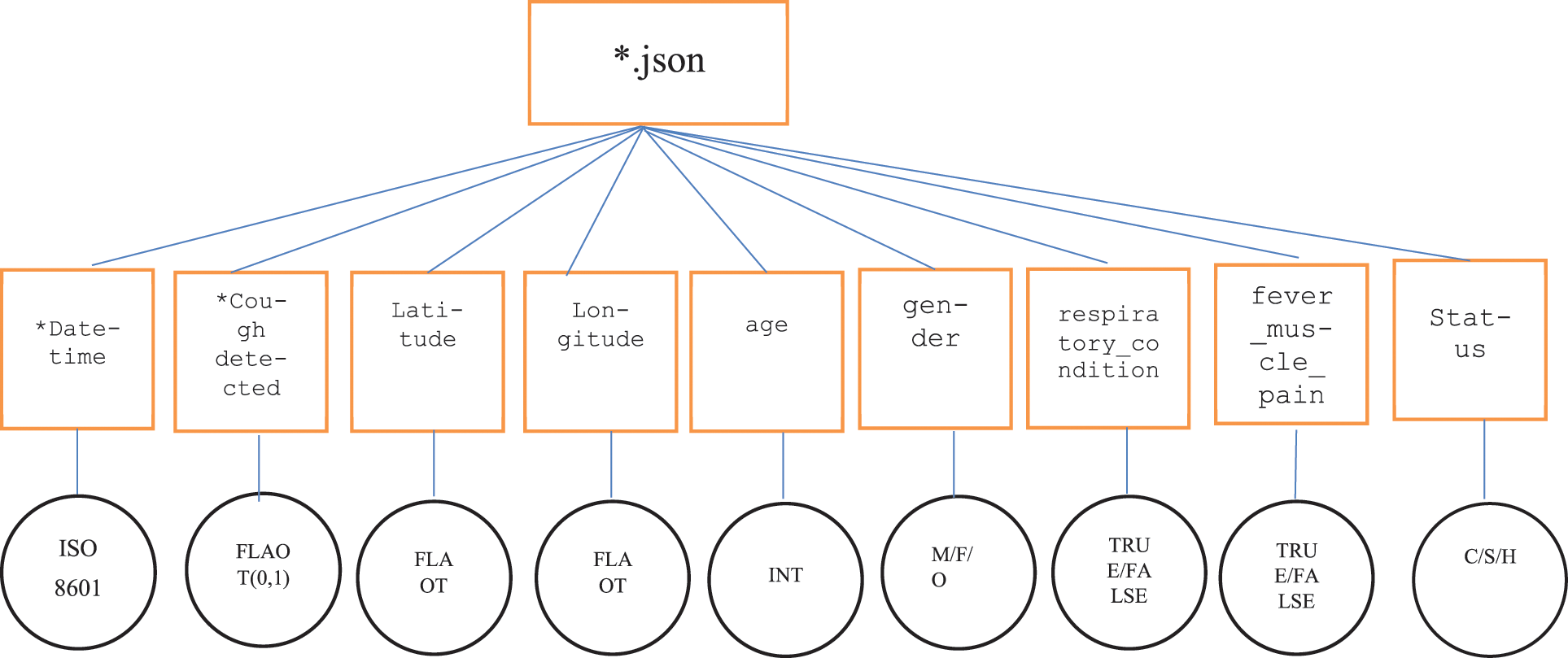
Figure 1: Description of each coughs dataset in COUGHVID crowdsource dataset
Each WEBM OR OGG file of the COUGHVID crowdsourced dataset was converted into WAV files, resampled into 16 kHz, and set into monotype. Figs. 2 and 3 describe the distribution of age and gender information found in the COUGHVID crowdsourcing dataset. It is found in the Fig. 3 that more male persons have participated than female candidates in COUGHVID crowdsourced dataset collection.

Figure 2: Distribution of ages in the COUGHVID crowdsourcing dataset
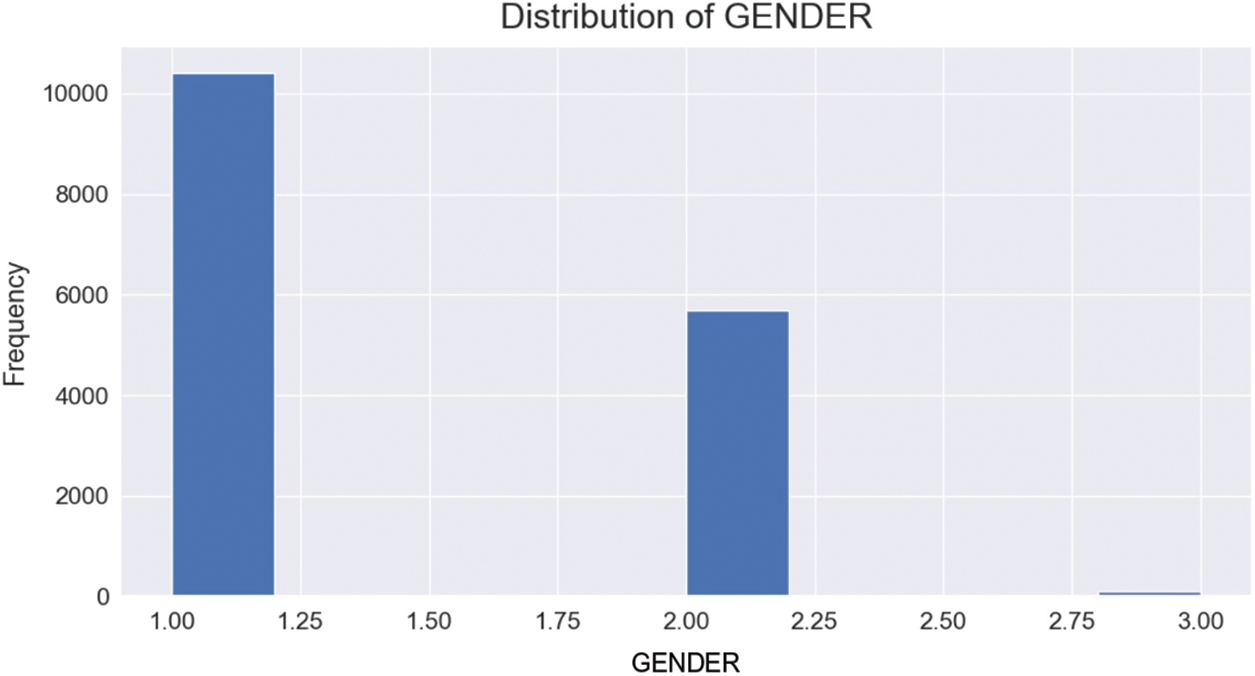
Figure 3: Male and female gender participants in the COUGHVID crowdsourcing dataset
Feature extraction plays a crucial role in detecting COVID-19 infection from noisy cough data using AI-based machine learning techniques. It is found in a survey made by Deshpande et al. [20] that 50% of the total efforts made for COVID-19 infection detection are based on MFCCs as feature vectors. Furthermore, it is also observed by Bader et al. [21] that MFCCs from the speech are not reliable features for segregating COVID-19-infected individuals and healthy individuals. Therefore, it was emphasized on two crucial parameters during feature extraction from COUGHVID crowdsource cough dataset, i.e., first, the noise robustness feature vector as the undertaken problem is dependent on the public crowdsource dataset, and second, the feature vector should be highly correlated in nature. Consequently, Gammatone Frequency Cepstral Coefficients (GFCCs) were considered feature vectors during the extraction stage that will fulfill noise robustness and correlate to the objectives [22]. The detailed process of GFCC extraction from the COUGHVID crowdsource cough data set is as follows [23]. GFCC Extraction algorithm is listed below:
a) Pass each COUGHVID crowdsource cough sound as an input signal through a 64-channel gammatone filterbank.
b) At each channel, the filter response is rectified and decimated to 100 Hz as a way of time windowing. Absolute value is taken afterward, creating a variant of the cochleagram in terms of time-frequency (T-F) representation.
c) Apply the cubic root on the output of the previous step, i.e., T-F representation.
d) Finally, DCT is applied to derive the cepstral features.
The filter is defined in the time domain by using impulse response, h(t), as in Eq. (1):
where a and b indicate the filter, t is time,
GFCCs are based on equivalent rectangular bandwidth (ERB) frequency scale and human data on ERB of the auditory filter with a function as in Eq. (2):
Glasburg et al. [24] suggested the following value to simulate auditory response of human hearers
where
3 Nature Inspired Meta-Heuristic-Based ANN
The main purpose of deer hunting, a nature-inspired meta-heuristic algorithm, is to find the optimal position for the hunters to attack the deer by studying the behavior of the deer [27]. Algorithm determines the first best solution as leader position, Hlead using fitness function and the Hlead, is treated as the first best position of the hunter and successor position, Hsuccessor, which is the position of the succeeding hunter [28–29]. The population of the hunter is represented as H1, H2, …. Hn.
Each individual in the population attempts to reach the goal point (best position) by updating the position in any random location within the space as the following Eqs. (3)–(5).
where imax is the maximum iteration,
The search space of the hunter is enhanced by incorporating the visualization angle of deer for a highly effective attack on the prey as Eq. (6):
The position angle,
where,
Now, the position is updated by using the position angle as Eq. (8):
The position is also updated on the successor position instead of the leader position as per the following Eq. (9):
The above equation is suitable for the vector L value greater than 1.
The algorithm for deer hunting optimization works as follows:
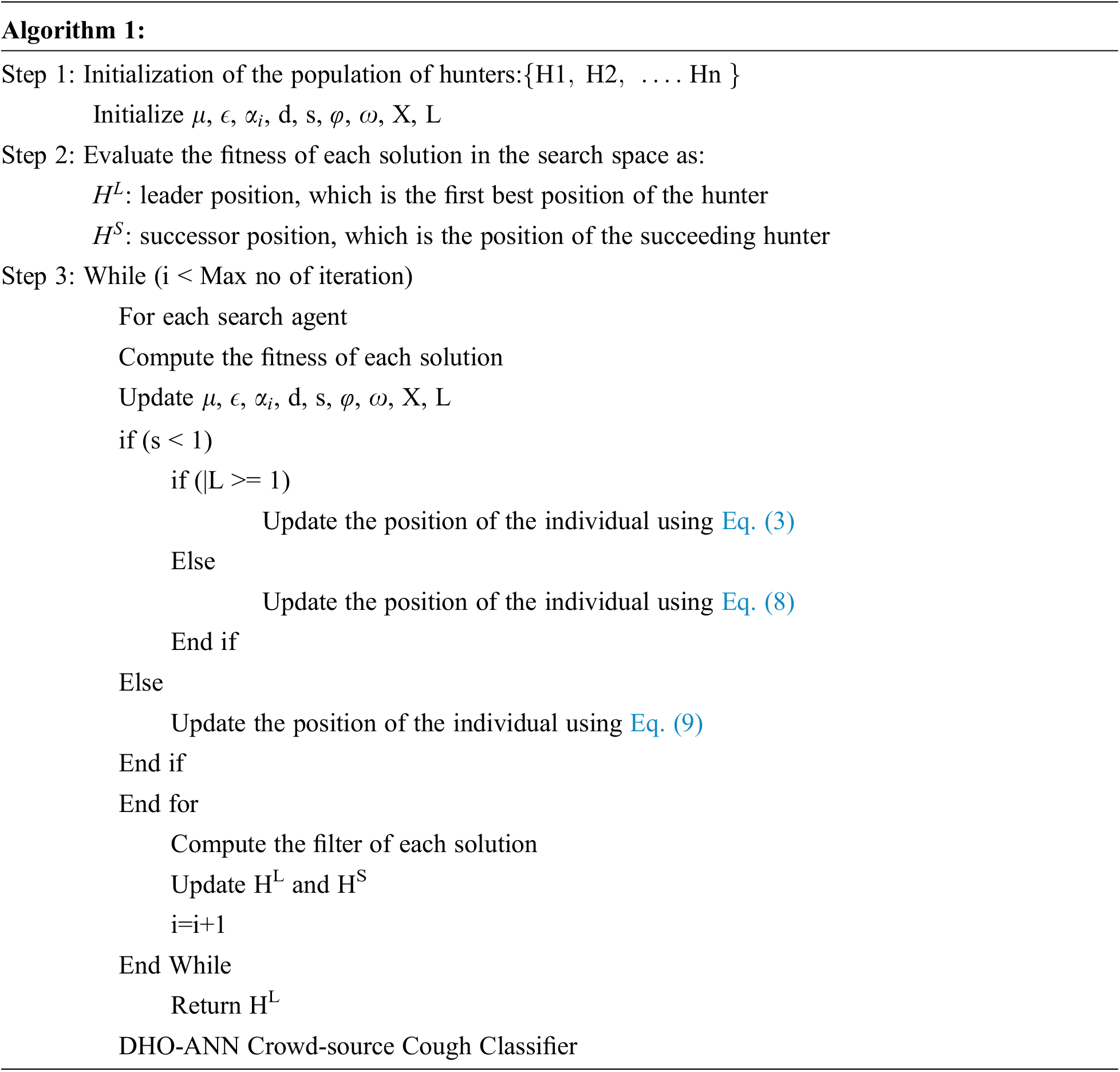
Now, it was focused on the blending of nature-inspired meta-heuristic DHO algorithm with neural network algorithm for better accuracy in COVID-19 detection instead of traditional approaches [30–31]
The values of weights and biases in artificial neural networks play a key role in the training phase of networks [32–35]. The performance of the artificial neural network is measured in terms of the average mean square error (MSE) as follows Eq. (10) [36–37].
where “M” represents the number of outputs, “N” represents the number of training samples, and
The particle swarm optimization (PSO) technique is categorized in bio-inspired algorithms, which are used to search for an optimal solution in the solution space [38]. This algorithm aims to approximate the global optimum by observing all particles during the run. Another optimization technique is Multi-Verse Optimizer (MVO) [39]. The MVO algorithm is categorized into white, black, and wormholes. These three concepts are correspondingly known for performing exploration, exploitation, and local search. One more optimization algorithm we hybridized with ANN is Cuckoo Search (CS) meta-heuristic optimization algorithm [40]. The CS optimization algorithm is based on the brood parasitism of selected cuckoo species considering Levy flight’s random walks.
DHO-ANN algorithm to detect the COVID-19 infection is shown in flowchart Fig. 4.
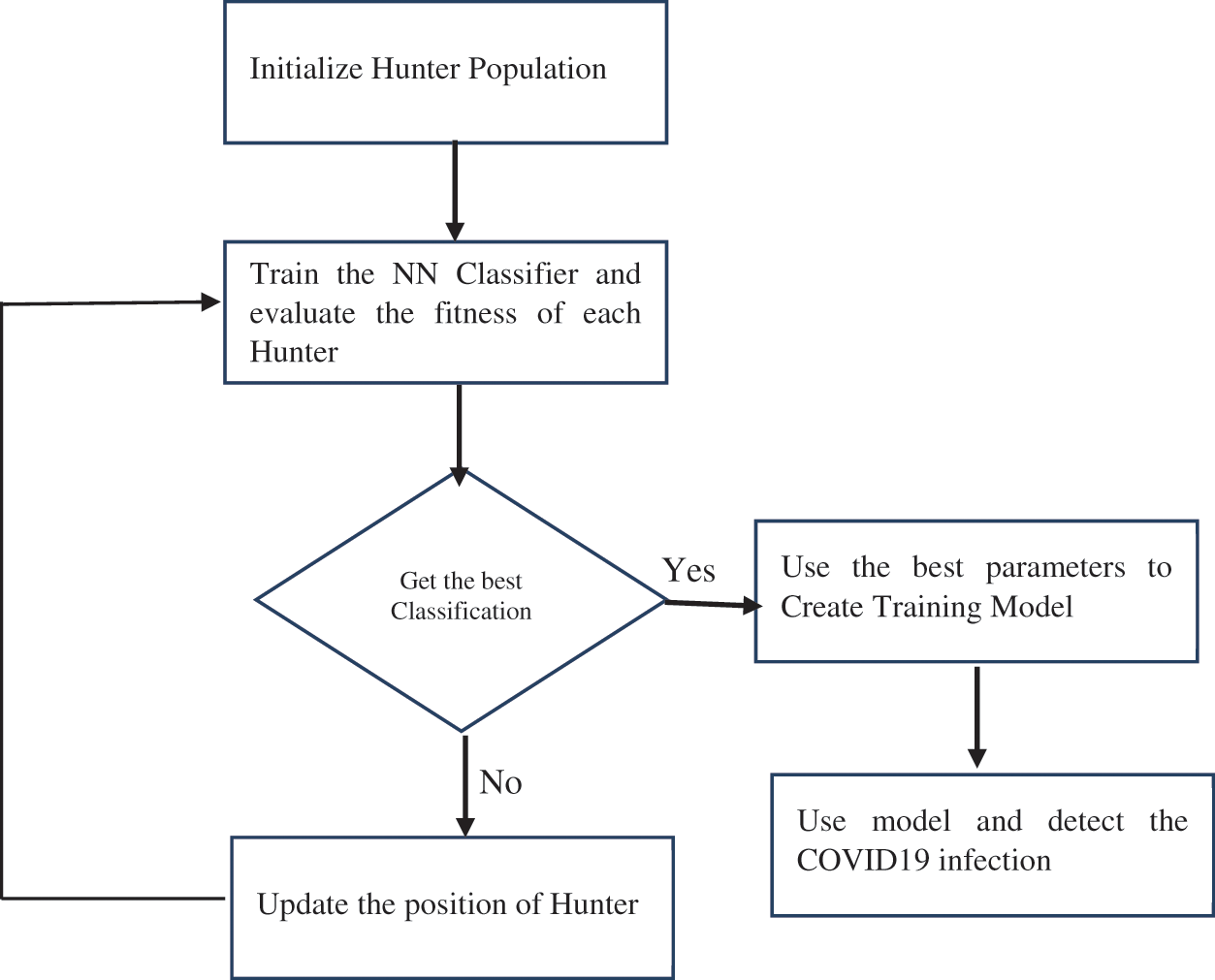
Figure 4: Flowchart of DHO-ANN algorithm to detect the COVID-19 infection
4 Application of HFG’s Laplacian Energy in Decision-Making
DHO-ANN, nature-inspired algorithm is having dependent parameters and those parameters are set to values that can improve the performance of detection of COVID-19 infection in noisy crowd sourced cough data set. Moreover, the dependent parameters also play crucial role in the stability, convergence, and robustness of DHO-ANN algorithm.
The performance of modified ANN based on deer hunting optimization, a nature-inspired meta-heuristic algorithm in terms of statistical analysis, F1 score over widely used feature parameter, MFCC, and noise-robust feature parameters, GFCC. Further, the proposed approach was compared with other existing models. Table 1 represents the performance of DHO-ANN over MFCC features generated from COUGHVID crowdsource cough data. Table 2 represents the performance of DHO-ANN over GFCC features generated from COUGHVID crowdsource cough data.


It is observed from Tables 1 and 2 that DHO-ANN performs comparatively better for other models and also found that DHO-ANN yielded pretty good performance in GFCC feature vectors as compared to MFCC feature vectors.
Further, the performance of the proposed algorithm is also analyzed over MFCC, and GFCC features in terms of confusion matrices are represented in Tables 3 and 4. It is found in Table 3 that the average accuracy of the proposed algorithm over MFCC features is 81.22%. The proposed algorithm yielded pretty better result over GFCC at 91.05 % as per Table 4.


The strength of undertaken cepstral coefficients was measured in MFCC and GFCC by using a statistical measure called correlation. The correlation graph of MFCC and GFCC is shown in Figs. 5 and 6, respectively.
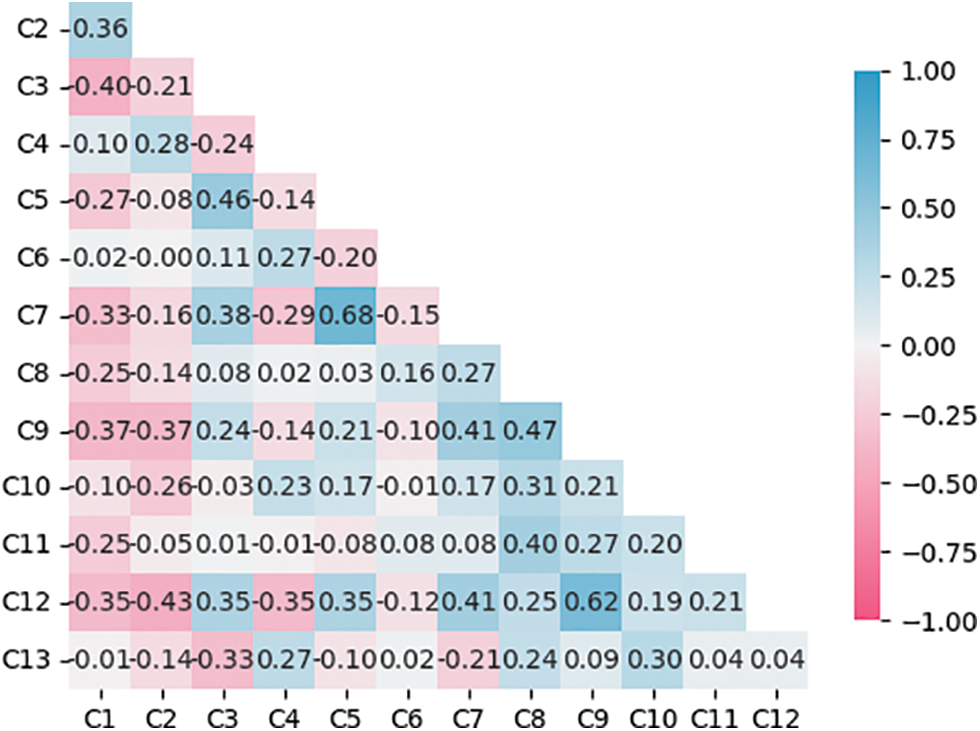
Figure 5: Correlation values over cepstral coefficients of MFCC in noisy crowd source cough data

Figure 6: Correlation values over cepstral coefficients of GFCC in noisy crowdsource cough data
It is observed from Figs. 5 and 6 that the cepstral coefficients of GFCC are high strength of the relationship as compared to MFCC.
The DHO-ANN algorithm was tested over highly correlated GFCC features from the noisy cough dataset using different iteration ranges. It is observed that the DHO-ANN algorithm results in smoother convergences between 60 to 100 iteration value ranges, as shown in Fig. 7.

Figure 7: Smoother convergence of DHO-ANN algorithm
Fig. 8 represents DHO-ANN algorithm performance for detecting COVID-19 disease from noisy cough data in terms Area under Curve (AUC) of Receiver Characteristic Operator (ROC) using GFCC feature parameters.
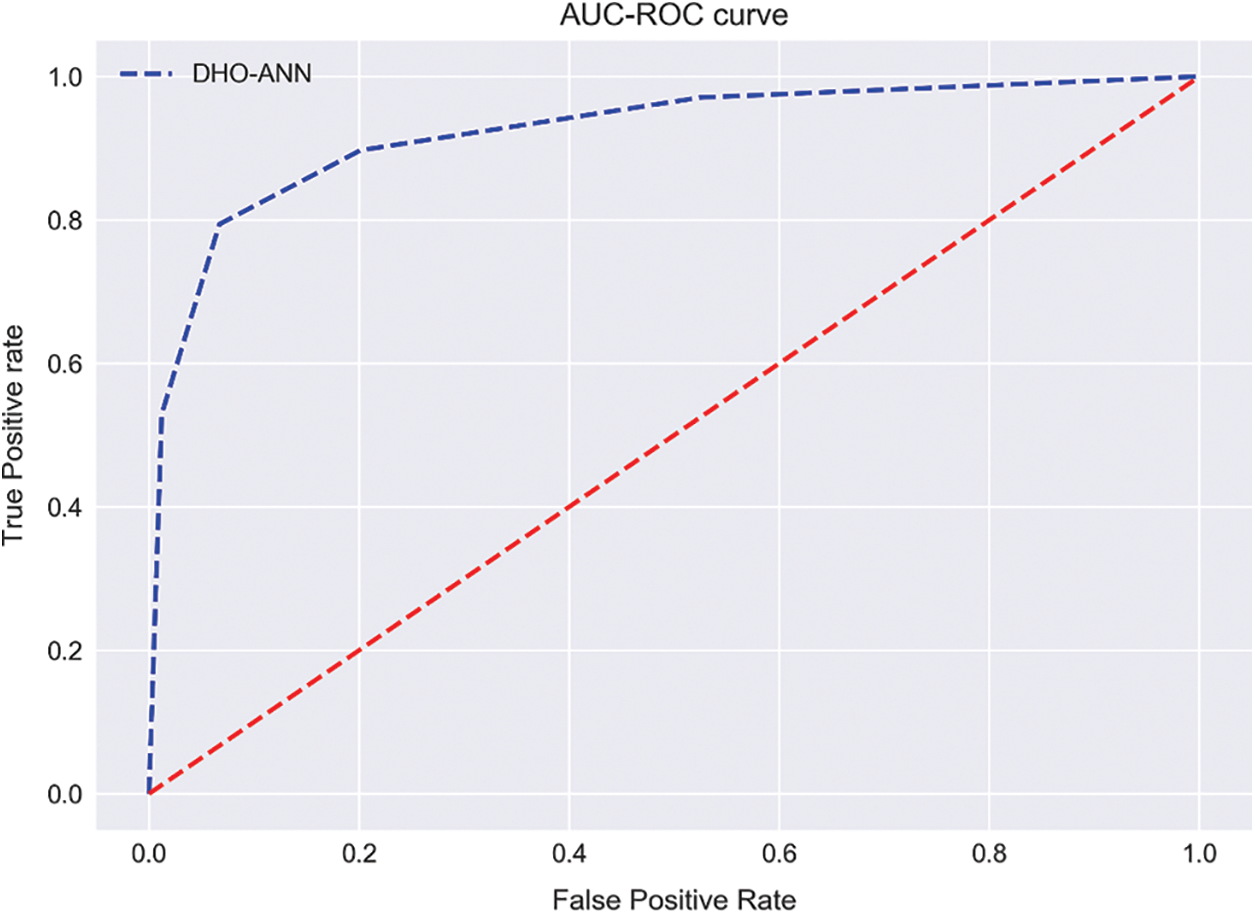
Figure 8: AUC-ROC of DHO-ANN algorithm
Further, the evaluation explored the ability of DHO-ANN to detect COVID-19 from noisy cough data set in terms of specificity and sensitivity parameters over two different feature parameters shown in Table 5.

A comparison was made of the proposed algorithm for detecting COVID-19 with other existing models for the same purpose, shown in Table 6.

It is observed in this research work that GFCCs performed better results as compared to MFCCs feature parameters for detecting COVID-19 in noisy crowdsourced cough data. Furthermore, it was obvious from the experimental results that the GFCCs were highly correlated feature parameters for COVID-19 detection rather than MFCCs. The proposed algorithm, DHO-ANN, yielded better results than other Machine Learning models such as PSO-ANN, MVO-ANN, and CS-ANN. Moreover, DHO-ANN performed comparatively superior by using GFCC features from noisy crowdsourced cough data set for the detection of COVID-19 and yielded 0.914 AUC-ROC values. It was found from the confusion matrix that the proposed algorithm yielded pretty better result over GFCC feature parameters as 91.05%. The proposed algorithm’s performance for detecting COVID-19 disease was rigorously validated using statistical measures, F1 score, confusion matrix, specificity, and sensitivity parameters. The specificity and sensitivity of DHO-ANN algorithm were found as 0.90 and 0.91 respectively for detection of COVID-19 from noisy cough data set over GFCC feature parameters. Moreover, it was evident that the proposed algorithm using GFCC performed superiorly in detecting the COVID-19 disease from the noisy crowdsourced cough dataset, COUGHVID. The proposed technique with undertaken feature parameters improved the detection of COVID-19 by at least 5% compared to other existing methods and feature parameters. As a future work direction, the focus may be on the impact of GFCC on detecting the COVID-19 disease under the noisy crowdsourced cough dataset using the nature-inspired meta-heuristic based Deep Neural Network (DNN) and convolutional auto-encoder neural network.
Funding Statement: The authors received no specific funding for this study.
Conflicts of Interest: The authors declare they have no conflicts of interest to report regarding the present study.
References
1. C. Brown, J. Chauhan, A. Grammenos, J. Han, A. Hasthanasombat et al., “Exploring automatic diagnosis of COVID-19 from crowdsourced respiratory sound data,” arXiv preprint, arXiv: 2006.05919, 2020. [Google Scholar]
2. O. R. Shahin, H. H. Alshammari, A. I. Taloba and R. M. Abd El-Aziz, “Machine learning approach for autonomous detection and classification of COVID-19 virus,” Computers and Electrical Engineering, vol. 101, no. 2, pp. 108055, 2022. [Google Scholar]
3. G. Chaudhari, X. Jiang, A. Fakhry, A. Han, J. Xiao et al., “Virufy: Global applicability of crowd sourced and clinical datasets for AI detection of COVID-19 from cough,” arXiv preprint, arXiv: 2020.13320, 2011. [Google Scholar]
4. S. Fouladi, M. J. Ebadi, A. A. Safaei, M. Y. Bajuri and A. Ahmadian, “Efficient deep neural networks for classification of COVID-19 based on CT images: Virtualization via software defined radio,” Computer Communications, vol. 176, no. 2, pp. 234–248, 2021. [Google Scholar]
5. S. Bhattacharya, P. K. R. Maddikunta, Q. V. Pham, T. R. Gadekallu, C. L. Chowdhary et al., “Deep learning and medical image processing for coronavirus (COVID-19) pandemic: A survey,” Sustainable Cities and Society, vol. 65, no. 13, pp. 102589, 2021. [Google Scholar]
6. V. K. Goar, N. S. Yadav, C. L. Chowdhary and M. Mittal, “An IoT and artificial intelligence-based patient care system focused on COVID-19 pandemic,” International Journal of Networking and Virtual Organisations, vol. 25, no. 3–4, pp. 232–251, 2021. [Google Scholar]
7. M. Aly, K. H. Rahouma and S. M. Ramzy, “Pay attention to the speech: COVID-19 diagnosis using machine learning and crowdsourced respiratory and speech recordings,” Alexandria Engineering Journal, vol. 61, no. 5, pp. 3487–3500, 2022. [Google Scholar]
8. WHO-China joint mission on coronavirus disease 2019 (COVID-192019. [Online]. Available: https://www.who.int/docs/default-source/coronaviruse/who-china-joint-mission-on-covid-19-final-report.pdf. [Google Scholar]
9. A. Mahashur, “Chronic dry cough: Diagnostic and management approaches,” Lung India, vol. 32, no. 1, pp. 44, 2015. [Google Scholar]
10. D. Grant, I. McLane and J. West, “Rapid and scalable COVID-19 screening using speech, breath, and cough recordings,” in IEEE EMBS Int. Conf. on Biomedical and Health Informatics (BHI), Athens, Greece, pp. 1–6, 2021. [Google Scholar]
11. B. Stasak, Z. Huang, S. Razavi, D. Joachim and J. Epps, “Automatic detection of COVID-19 based on short-duration acoustic smartphone speevoice analysis,” Journal of Healthcare Informatics Research, vol. 5, no. 2, pp. 201–217, 2021. [Google Scholar]
12. T. K. Dash, S. Mishra, G. Panda and S. C. Satapathy, “Detection of COVID-19 from speech signal using bio-inspired based cepstral features,” Pattern Recognition, vol. 117, no. 1, pp. 107999, 2021. [Google Scholar]
13. N. Sharma, P. Krishnan, R. Kumar, S. Ramoji, S. R. Chetupalli et al., “Coswara-a database of breathing, cough, and voice sounds for COVID-19 diagnosis,” ArXiv abs/2005.10548, 2020. [Google Scholar]
14. B. W. Schuller, A. Batliner, C. Bergler, C. Mascolo, J. Han et al., “The INTERSPEECH 2021 computational paralinguistics challenge: COVID-19 cough, COVID-19 speech, escalation & primates,” in 22nd Annual Conf. of the Int. Speech Communication Association, INTERSPEECH, Brno, Czech Republic, pp. 4291–4295, 2021 [Google Scholar]
15. I. Miranda, A. Diacon and T. Niesler, “A comparative study of features for acoustic cough detection using deep architectures,” in Annual Int. Conf. of the IEEE Engineering in Medicine and Biology Society. IEEE Engineering in Medicine and Biology Society, Berlin, Germany, pp. 2601–2605, 2019. [Google Scholar]
16. J. Monge-Alvarez, C. Hoyos-Barceló, P. Lesso and P. Casaseca-de-la-Higuera, “Robust detection of audio-cough events using local hu moments,” IEEE Journal of Biomedical and Health Informatics, vol. 23, no. 1, pp. 184–196, 2019. [Google Scholar]
17. T. F. Quatieri, T. Talkar and J. S. Palmer, “A framework for biomarkers of COVID-19 based on coordination of speech-production subsystems,” IEEE Open Journal of Engineering in Medicine and Biology, vol. 1, pp. 203–206, 2020. [Google Scholar]
18. B. W. Schuller, D. M. Schuller, K. Qian, J. Liu, H. Zheng et al., “COVID-19 and computer audition: An overview on what speech & sound analysis could contribute in the SARS-CoV-2 corona crisis,” Frontiers in Digital Health, vol. 14, pp. 1–10, 2021. [Google Scholar]
19. L. Orlandic, T. Teijeiro and D. Atienz, “The COUGHVID crowdsourcing dataset, a corpus for the study of large-scale cough analysis algorithms,” Scientific Data, vol. 8, no. 1, pp. 1–10, 2021. [Google Scholar]
20. G. Deshpande, A. Batliner and B. W. Schuller, “AI-based human audio processing for COVID-19: A comprehensive overview,” Pattern Recognition, vol. 122, no. 3, pp. 108289, 2022. [Google Scholar]
21. M. Bader, I. Shahin and A. Hassan, “Studying the similarity of COVID-19 sounds based on correlation analysis of MFCC,” in Int. Conf. on Communications, Computing, Cybersecurity, and Informatics (CCCI), Sharjah, United Arab Emirates, pp. 1–5, 2020. [Google Scholar]
22. Y. Zhang and L. Ni, “Feature extraction algorithm fusing GFCC and phase information,” in IEEE 2nd Advanced Information Technology, Electronic and Automation Control Conf. (IAEAC), Chongqing, China, pp. 1163–1167, 2017. [Google Scholar]
23. J. M. Liu, M. You, G. -Z. Li, Z. Wang, X. Xu et al., “Cough signal recognition with gammatone cepstral coefficients,” in IEEE China Summit and Int. Conf. on Signal and Information Processing, Beijing, China, pp. 160–164, 2013. [Google Scholar]
24. B. Glasberg and B. Moore, “Derivation of auditory filter shapes from notched-noise data,” Hearing Research, vol. 47, no. 1–2, pp. 103–138, 1990. [Google Scholar]
25. X. Zhao and D. Wang, “Analyzing noise robustness of MFCC and GFCC features in speaker identification,” in IEEE Int. Conf. on Acoustics, Speech and Signal Processing, Vancouver, BC, Canada, pp. 7204–7208, 2013. [Google Scholar]
26. X. Shi, H. Yang and P. Zhou, “Robust speaker recognition based on improved GFCC,” in 2nd IEEE Int. Conf. on Computer and Communications (ICCC), Chengdu, China, pp. 1927–1931, 2016. [Google Scholar]
27. G. Brammya, S. Praveena, N. S. Ninu Preetha, R. Ramya, R. B. Rajakumar et al., “Deer hunting optimization algorithm: A new nature-inspired meta-heuristic paradigm,” The Computer Journal, vol. 27, pp. 1053, 2019. [Google Scholar]
28. M. -W. Tian, S. -R. Yan, S. -Z. Han, S. Nojavan, K. Jermsittiparsert et al., “New optimal design for a hybrid solar chimney, solid oxide electrolysis and fuel cell based on improved deer hunting optimization algorithm,” Journal of Cleaner Production, vol. 249, no. 10, pp. 119414, 2020. [Google Scholar]
29. W. Fang, X. Li, M. Zhang and M. Hu, “Nature-inspired algorithms for real-world optimization problems,” Journal of Applied Mathematics, vol. 2015, pp. 1–2, 2015. [Google Scholar]
30. C. Brown, J. Chauhan, A. Grammenos, J. Han, A. Hasthanasombat et al., “Exploring automatic diagnosis of COVID-19 from crowdsourced respiratory sound data,” arXiv preprint, arXiv: 2006.05919, 2020. [Google Scholar]
31. J. Han, C. Brown, J. Chauhan, A. Grammenos, A. Hasthanasombat et al., “Exploring automatic COVID-19 diagnosis via voice and symptoms from crowdsourced data,” in IEEE Int. Conf. on Acoustics, Speech and Signal Processing (ICASSP), Toronto, Canada, pp. 8328–8332, 2021. [Google Scholar]
32. H. M. Ahmed, B. A. Youssef, A. S. Elkorany, A. A. Saleeb and F. A. El-Samieet, “Hybrid gray wolf optimizer-artificial neural network classification approach for magnetic resonance brain images,” Applied optics, vol. 57, no. 7, pp. B25–B32, 2018. [Google Scholar]
33. H. Faris, I. Aljarah, S. Mirjalili, P. Castillo and J. J. Merelo, “EvoloPy: An open-source nature-inspired optimization framework in python,” in Proc. of the 8th Int. Joint Conf. on Computational Intelligence, ECTA, Porto, Portugal, vol. 3, pp. 171–177, 2016. [Google Scholar]
34. A. M. Hemeida, S. A. Hassan, A. A. A. Mohamed, S. Alkhalaf, M. M. Mahmoud et al., “Nature-inspired algorithms for feed-forward neural network classifiers: A survey of one decade of research,” Ain Shams Engineering Journal, vol. 11, no. 3, pp. 659–675, 2020. [Google Scholar]
35. P. Lanillos, D. Oliva, A. Philippsen, Y. Yamashita, Y. Nagai et al., “A review on neural network models of schizophrenia and autism spectrum disorder,” Neural Networks, vol. 122, no. 1, pp. 338–363, 2020. [Google Scholar]
36. A. Castillo-Allendes, F. Contreras-Ruston, L. C. Cantor-Cutiva, J. Codino, M. Guzman et al., “Voice therapy in the Context of the COVID-19 pandemic: Guidelines for clinical practice,” Journal of Voice, vol. 35, no. 5, pp. 717–727, 2021. [Google Scholar]
37. J. L. Aljohani, E. S. Alaidarous, M. A. Z. Raja, M. Shoaib and M. S. Alhothuali, “Intelligent computing through neural networks for numerical treatment of non-Newtonian wire coating analysis model,” Scientific Reports, vol. 11, no. 1, pp. 1–32, 2021. [Google Scholar]
38. T. M. Shami, A. A. El-Saleh, M. Alswaitti, Q. Al-Tashi, M. A. Summakieh et al., “Particle swarm optimization: A comprehensive survey,” IEEE Access, vol. 10, pp. 10031–10061, 2022. [Google Scholar]
39. L. Abualigah and M. Alkhrabsheh, “Amended hybrid multi-verse optimizer with genetic algorithm for solving task scheduling problem in cloud computing,” The Journal of Supercomputing, vol. 78, no. 1, pp. 740–765, 2022. [Google Scholar]
40. T. Cuong-Le, H. -L. Minh, S. Khatir, M. A. Wahab, M. T. Tran et al., “A novel version of cuckoo search algorithm for solving optimization problems,” Expert Systems with Applications, vol. 186, no. 4, pp. 115669, 2021. [Google Scholar]
Cite This Article
 Copyright © 2023 The Author(s). Published by Tech Science Press.
Copyright © 2023 The Author(s). Published by Tech Science Press.This work is licensed under a Creative Commons Attribution 4.0 International License , which permits unrestricted use, distribution, and reproduction in any medium, provided the original work is properly cited.


 Submit a Paper
Submit a Paper Propose a Special lssue
Propose a Special lssue View Full Text
View Full Text Download PDF
Download PDF Downloads
Downloads
 Citation Tools
Citation Tools